On the Relationship between Gravity Waves and Tropopause Height and Temperature over the Globe Revealed by COSMIC Radio Occultation Measurements
Abstract
1. Introduction
2. Experiments
2.1. COSMIC RO Data
2.2. GW Ep
2.3. LRT and CPT Temperature and Height
2.4. Statistical Method
3. Results
3.1. Calculation Example
3.2. The Vertical Structure of the Correlation Between Ep and Tropopause Parameters
3.3. The Horizontal Structures of the Correlations Between Ep and Tropopause Parameters
3.4. The Relationship between Convection and Tropopause in the Tropics
4. Discussion
5. Conclusions
Author Contributions
Funding
Acknowledgments
Conflicts of Interest
References
- Son, S.W.; Tandon, N.F.; Polvani, L.M. The fine-scale structure of the global tropopause derived from COSMIC GPS radio occultation measurements. J. Geophys. Res. 2011, 116, D20113. [Google Scholar] [CrossRef]
- Holton, J.R.; Haynes, P.H.; McIntyre, M.E.; Douglass, A.R.; Rood, R.B.; Pfister, L. Stratosphere-troposphere exchange. Rev. Geophys. 1995, 33, 403–439. [Google Scholar] [CrossRef]
- Sausen, R.; Santer, B.D. Use of changes in tropopause height to detect human influences on climate. Meteorol. Z. 2003, 12, 131–136. [Google Scholar] [CrossRef]
- Schmidt, T.; de la Torre, A.; Wickert, J. Global gravity wave activity in the tropopause region from CHAMP radio occultation data. Geophys. Res. Lett. 2008, 35, 428–451. [Google Scholar] [CrossRef]
- Schmidt, T.; Beyerle, G.; Heise, S.; Wickert, J.; Rothacher, M. A climatology of multiple tropopauses derived from GPS radio occultations with CHAMP and SAC-C. J. Geophys. Res. Lett. 2006, 33, L04808. [Google Scholar] [CrossRef]
- Liu, Y.; Xu, T.; Liu, J. Characteristics of the seasonal variation of the global tropopause revealed by COSMIC/GPS data. Adv. Space Res. 2014, 54, 2274–2285. [Google Scholar] [CrossRef]
- Randel, W.J.; Jensen, E.J. Physical processes in the tropical tropopause layer and their roles in a changing climate. Nat. Geosci. 2013, 6, 169–176. [Google Scholar] [CrossRef]
- Yulaeva, E.; Holton, J.; Wallace, J. On the cause of the annual cycle in tropical lower-stratospheric temperatures. J. Atmos. Sci. 1994, 51, 169–174. [Google Scholar] [CrossRef]
- Zhou, X.; Holton, J.R. Intraseasonal Variations of Tropical Cold-Point Tropopause Temperatures. J. Clim. 2002, 15, 1460–1473. [Google Scholar] [CrossRef]
- Randel, W.J.; Wu, F.; Ríos, W.R. Thermal variability of the tropical tropopause region derived from GPS/MET observations. J. Geophys. Res. 2003, 108, 4020. [Google Scholar] [CrossRef]
- Seidel, D.J.; Randel, W.J. Variability and trends in the global tropopause estimated from radiosonde data. J. Geophys. Res. 2006, 111, D21101. [Google Scholar] [CrossRef]
- Son, S.W.; Lee, S. Intraseasonal Variability of the Zonal-Mean Tropical Tropopause Height. J. Atmos. Sci. 2007, 64, 2695–2706. [Google Scholar] [CrossRef]
- Tsuda, T.; Murayama, Y.; Wiryosumarto, H.; Harijono, S.W.B.; Kato, S. Radiosonde observations of equatorial atmosphere dynamics over Indonesia: 2. Characteristics of gravity waves. J. Geophys. Res. 1994, 99, 10507–10516. [Google Scholar] [CrossRef]
- Boehm, M.T.; Verlinde, J. Stratospheric influence on upper tropospheric tropical cirrus. Geophys. Res. Lett. 2000, 27, 3209–3212. [Google Scholar] [CrossRef]
- Satheesan, K.; Murthy, B.V.K. Modulation of tropical tropopause by wave disturbances. J. Atmos. Sol-Terr. Phys. 2005, 67, 878–883. [Google Scholar] [CrossRef]
- Jain, A.R.; Das, S.S.; Mandal, T.K.; Mitra, A.P. Observations of extremely low temperature over the Indian tropical region during monsoon and post monsoon months: Possible implications. J. Geophys. Res. 2006, 111, D07106. [Google Scholar] [CrossRef]
- Das, S.S.; Kumar, K.K.; Uma, K.N. MST radar investigation on inertia-gravity waves associated with tropical depression in the upper troposphere and lower stratosphere over Gadanki (13.5 degrees N, 79.2 degrees E). J. Atmos. Sol-Terr. Phys. 2010, 72, 1184–1194. [Google Scholar]
- Khan, A.; Jin, S. Effect of Gravity Waves on the Tropopause Temperature, Height and Water Vapor in Tibet from COSMIC GPS Radio Occultation Observations. J. Atmos. Sol-Terr. Phys. 2016, 138, 23–31. [Google Scholar] [CrossRef]
- Zhang, Y.; Zhang, S.; Huang, C.; Huang, K.; Gong, Y.; Gan, Q. The interaction between the tropopause inversion layer and the inertial gravity wave activities revealed by radiosonde observations at a midlatitude station. J. Geophys. Res. 2015, 120, 8099–8111. [Google Scholar] [CrossRef]
- Moustaoui, M.; Joseph, B.; Teitelbaum, H. Mixing layer formation near the tropopause due to gravity wave-critical level interactions in a cloud-resolving model. J. Atmos. Sci. 2004, 61, 3112–3124. [Google Scholar] [CrossRef]
- Wang, L.; Alexander, M.J. Global estimates of gravity wave parameters from GPS radio occultation temperature data. J. Geophys. Res. 2010, 115, D21122. [Google Scholar] [CrossRef]
- Seidel, D.J.; Rebecca, J.R.; James, K.A. Climatological characteristics of the tropical tropopause as revealed by radiosondes. J. Geophys. Res. 2001, 106, 7857–7878. [Google Scholar] [CrossRef]
- Schmidt, T.; Wickert, J.; Beyerle, G.; Reigber, C. Tropical tropopause parameters derived from GPS radio occultation measurements with CHAMP. J. Geophys. Res. 2004, 109, D13105. [Google Scholar] [CrossRef]
- Sivakumar, V.; Bencherif, H.; Bègue, N.; Thompson, A.M. Tropopause characteristics and variability from 11 yr of SHADOZ observations in the southern tropics and subtropics. J. Appl. Meteorol. Climatol. 2011, 50, 1403–1416. [Google Scholar] [CrossRef]
- Xu, X.; Gao, P.; Zhang, X. Global multiple tropopause features derived from COSMIC radio occultation data during 2007 to 2012. J. Geophys. Res. 2014, 119, 8515–8534. [Google Scholar] [CrossRef]
- Ratnam, M.V.; Tetzlaff, G.; Jacobi, C. Global and seasonal variations of stratospheric gravity wave activity deduced from the CHAMP/GPS satellite. J. Atmos. Sci. 2004, 61, 1610–1620. [Google Scholar] [CrossRef]
- Hindley, N.P.; Wright, C.J.; Smith, N.D.; Mitchell, N.J. The southern stratospheric gravity wave hot spot: individual waves and their momentum fluxes measured by COSMIC GPS-RO. Atmos. Chem. Phys. 2015, 15, 7797–7818. [Google Scholar] [CrossRef]
- Das, S.S.; Jain, A.R.; Kumar, K.K.; Rao, D.N. Diurnal variability of the tropical Tropopause: Significance of VHF radar measurements. Radio Sci. 2008, 43, RS6003. [Google Scholar] [CrossRef]
- Nishida, M.; Shimizu, A.; Tsuda, T.; Rocken, C.; Ware, R.H. Seasonal and longitudinal variations in the tropical tropopause observed with the GPS occultation technique (GPS/MET). J. Meteorol. Soc. Jpn. 2000, 78, 691–700. [Google Scholar] [CrossRef]
- Alexander, S.P.; Tsuda, T.; Kawatani, Y. COSMIC GPS observations of Northern Hemisphere winter stratospheric gravity waves and comparisons with an atmospheric general circulation model. Geophys. Res. Lett. 2008, 35, L10808. [Google Scholar] [CrossRef]
- Schmidt, T.; Alexander, P.; de la Torre, A. Stratospheric gravity wave momentum flux from radio occultations. J. Geophys. Res. 2016, 121, 4443–4467. [Google Scholar] [CrossRef]
- Wang, L.; Alexander, M.J. Gravity wave activity during stratospheric sudden warmings in the 2007–2008 Northern Hemisphere winter. J. Geophys. Res. 2009, 114, D18108. [Google Scholar] [CrossRef]
- Stockwell, R.G.; Mansinha, L.; Lowe, R.P. Localisation of the complex spectrum: The S-transform. IEEE Trans. Signal Process. 1996, 44, 998–1001. [Google Scholar] [CrossRef]
- Xu, X.; Yu, D.; Luo, J. Seasonal variations of global stratospheric gravity wave activity revealed by COSMIC RO data. In Proceedings of the CPGPS 2017 Forum on Cooperative Positioning and Service, Harbin, China, 19–21 May 2017. [Google Scholar]
- Xu, X.; Yu, D.; Luo, J. The spatial and temporal variability of global stratospheric gravity waves and their activity during SSW revealed by COSMIC measurements. Adv. Atmos. Sci. 2018, 35, 1533–1546. [Google Scholar] [CrossRef]
- Khandu; Awange, J.L.; Forootan, E. Interannual variability of temperature in the UTLS region over Ganges-Brahmaputra-Meghna river basin based on COSMIC GNSS RO data. Atmos. Meas. Tech. 2016, 9, 1685–1699. [Google Scholar] [CrossRef]
- Mohanakumar, K. Stratosphere Troposphere Interactions; Springer: London, UK, 2008. [Google Scholar]
- Kim, J.; Son, S.W. Tropical Cold-Point Tropopause: Climatology, Seasonal Cycle and Intraseasonal Variability derived from COSMIC GPS Radio Occultation Measurements. J. Clim. 2012, 25, 5343–5360. [Google Scholar] [CrossRef]
- Ratnam, M.V.; Tsuda, T.; Kozu, T.; Mori, S. Long-term behavior of the Kelvin waves revealed by CHAMP/GPS RO measurements and their effects on the tropopause structure. Ann. Geophys. 2006, 24, 1355–1366. [Google Scholar] [CrossRef]
- Tsuda, T.; Nishida, M.; Rocken, C.; Ware, R.H. A global morphology of gravity wave activity in the stratosphere revealed by the GPS occultation data (GPS/MET). J. Geophys. Res. 2000, 105, 7257–7273. [Google Scholar] [CrossRef]
- Faber, A.; Llamedo, P.; Schmidt, T.; de la Torre, A.; Wickert, J. On the Determination of Gravity Wave Momentum Flux from GPS Radio Occultation Data. Atmos. Meas. Tech. 2013, 6, 3169–3180. [Google Scholar] [CrossRef]
- Gettelman, A.; Salby, M.L.; Sassi, F. Distribution and influence of convection in the tropical tropopause region. J.Geophys. Res. 2002, 107, 4080. [Google Scholar] [CrossRef]
- Ryu, J.H.; Lee, S.; Son, S.W. Vertically Propagating Kelvin Waves and Tropical Tropopause Variability. J. Atmos. Sci. 2007, 65, 1817–1837. [Google Scholar] [CrossRef]
- Alexander, M.J.; Tsuda, T.; Vincent, R.A. Latitudinal variations observed in gravity waves with short vertical wavelengths. J. Atmos. Sci. 2002, 59, 1394–1404. [Google Scholar] [CrossRef]
- Wang, P.K. Moisture plumes above thunderstorm anvils and their contributions to cross-tropopause transport of water vapor in midlatitudes. J. Geophys. Res. 2003, 108, 4194. [Google Scholar] [CrossRef]
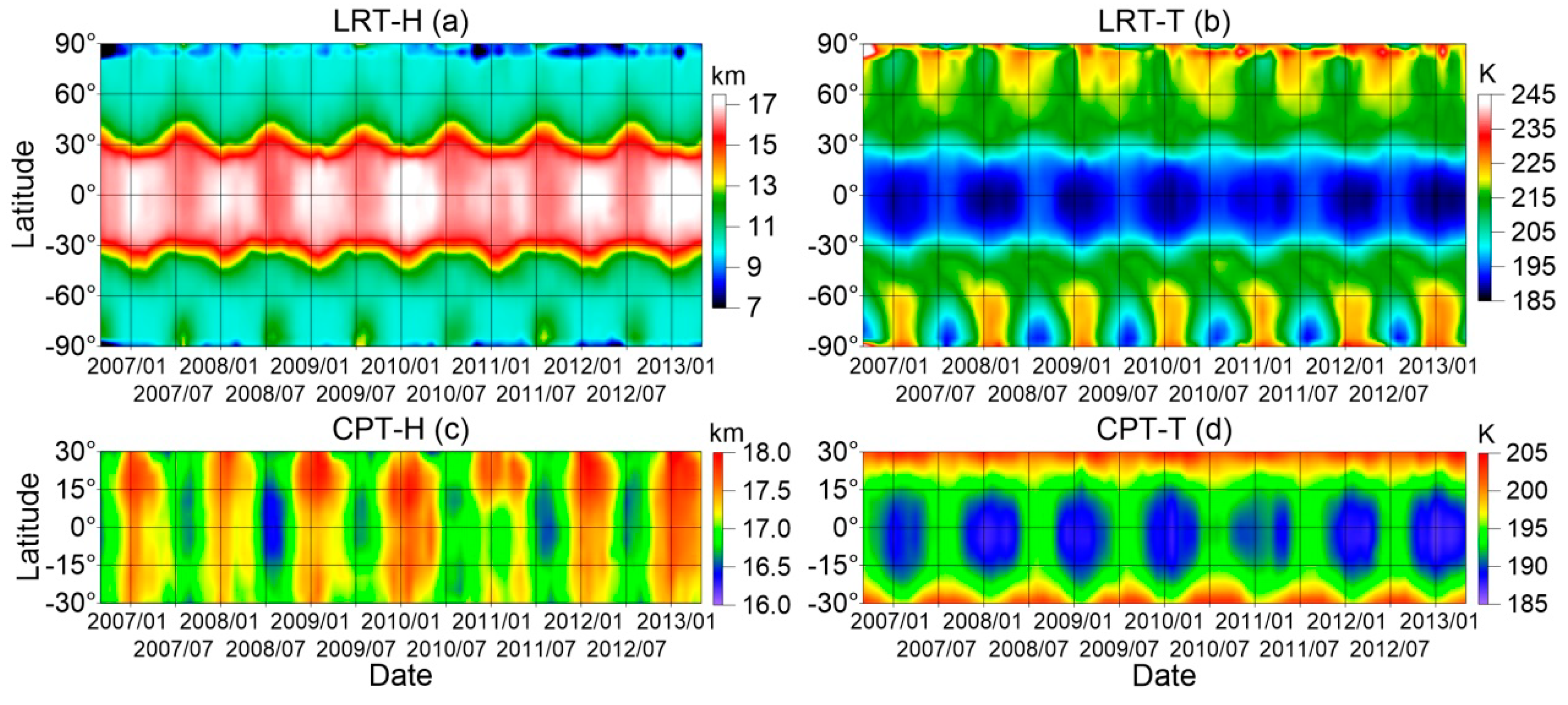

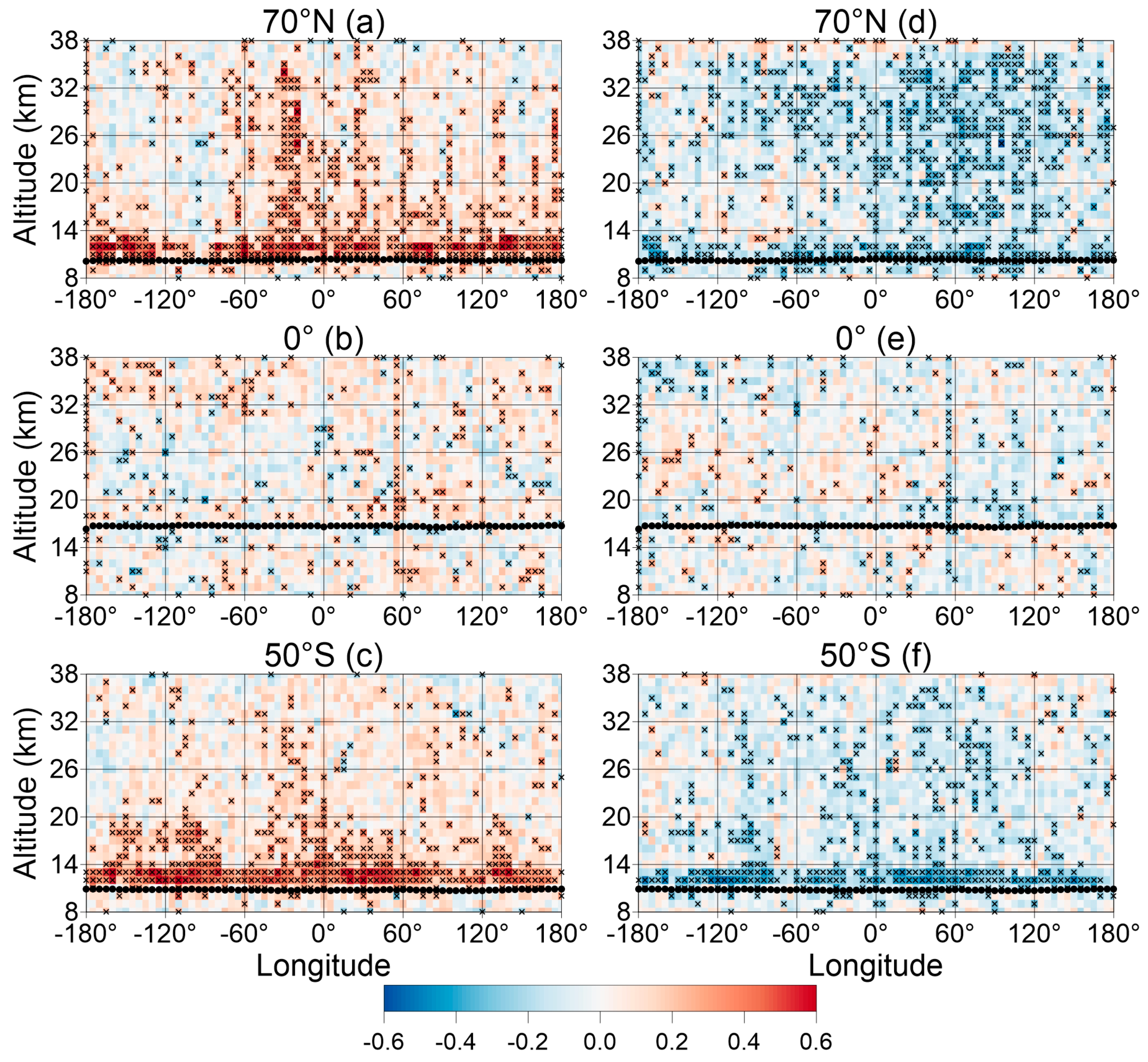
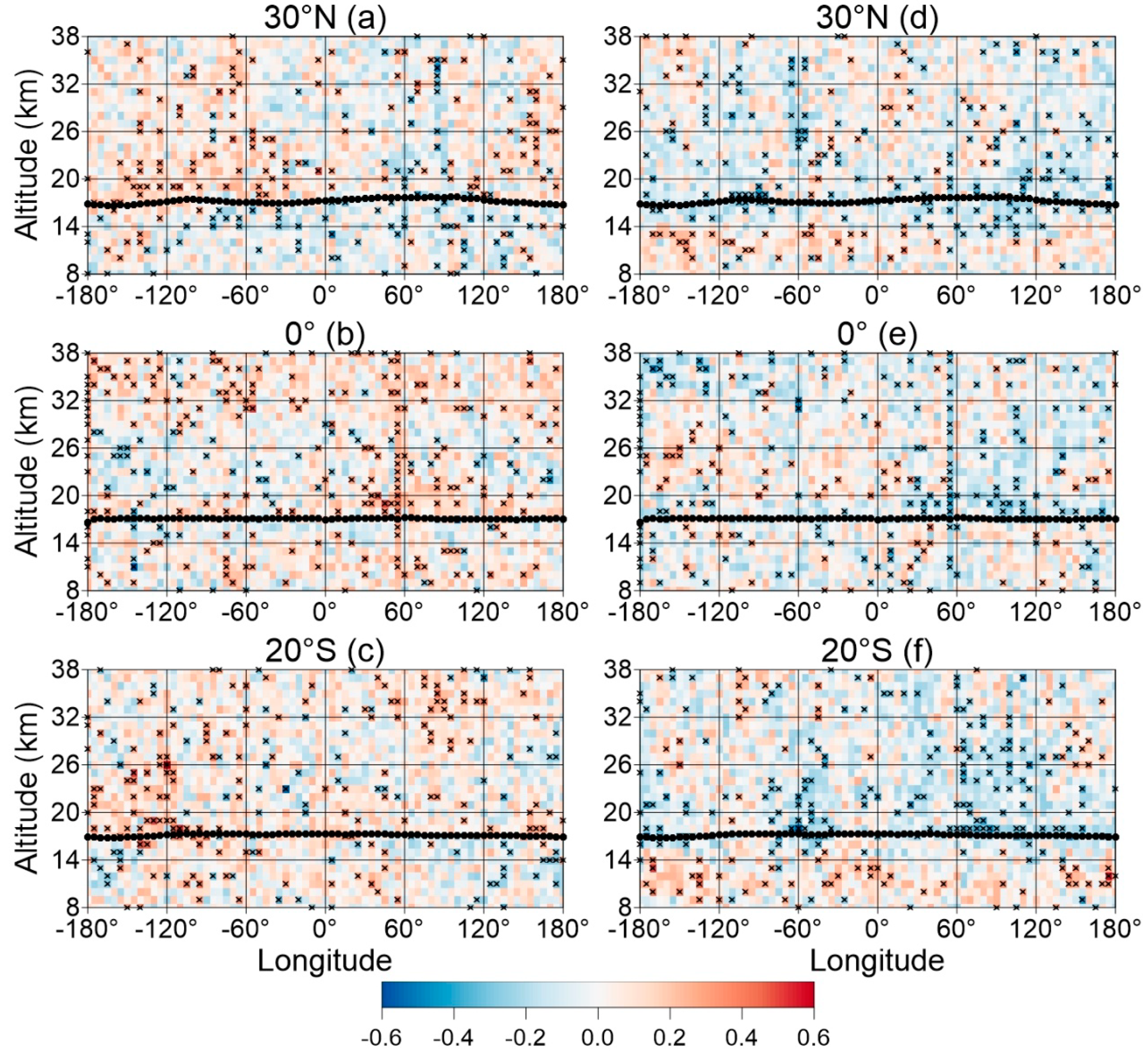
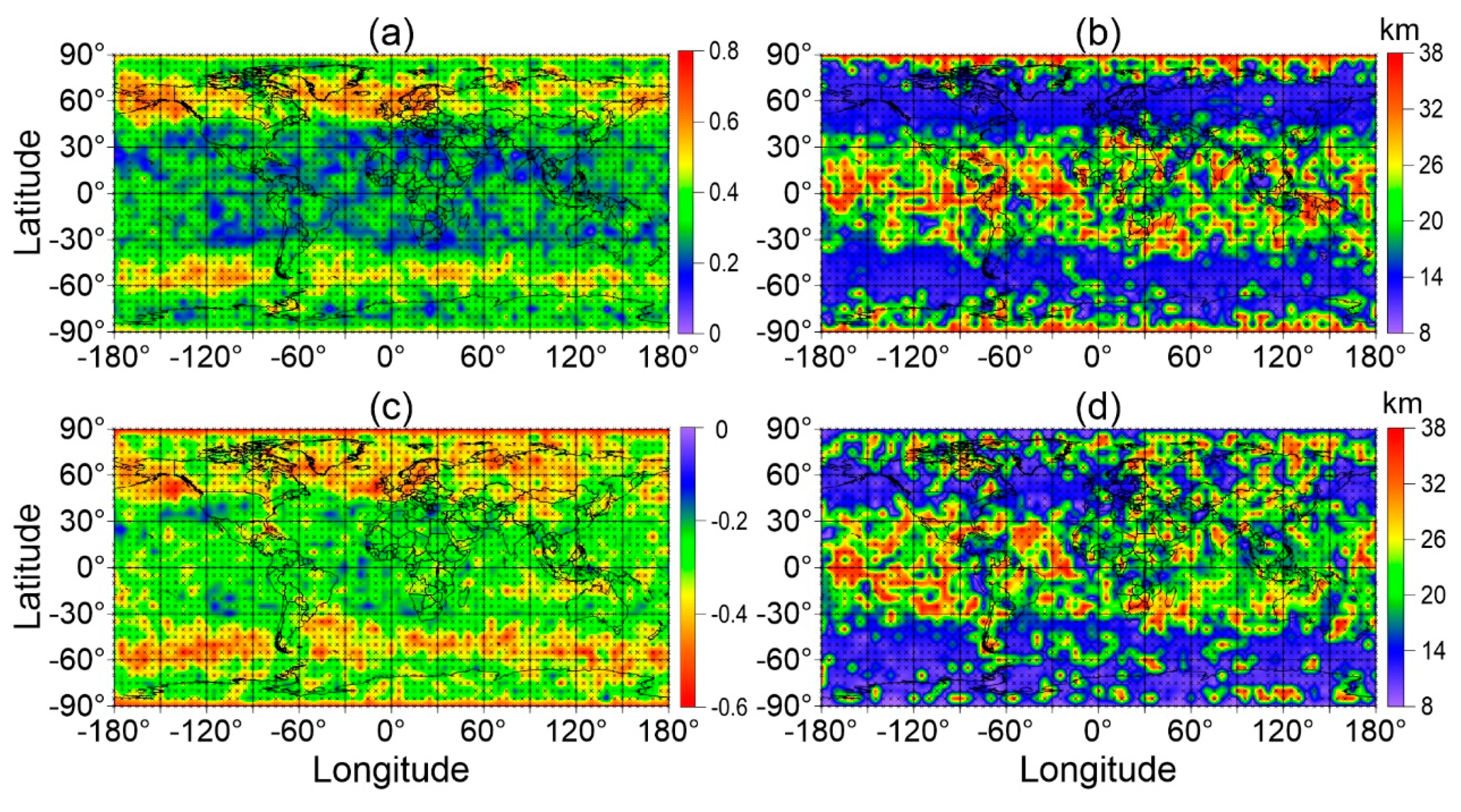
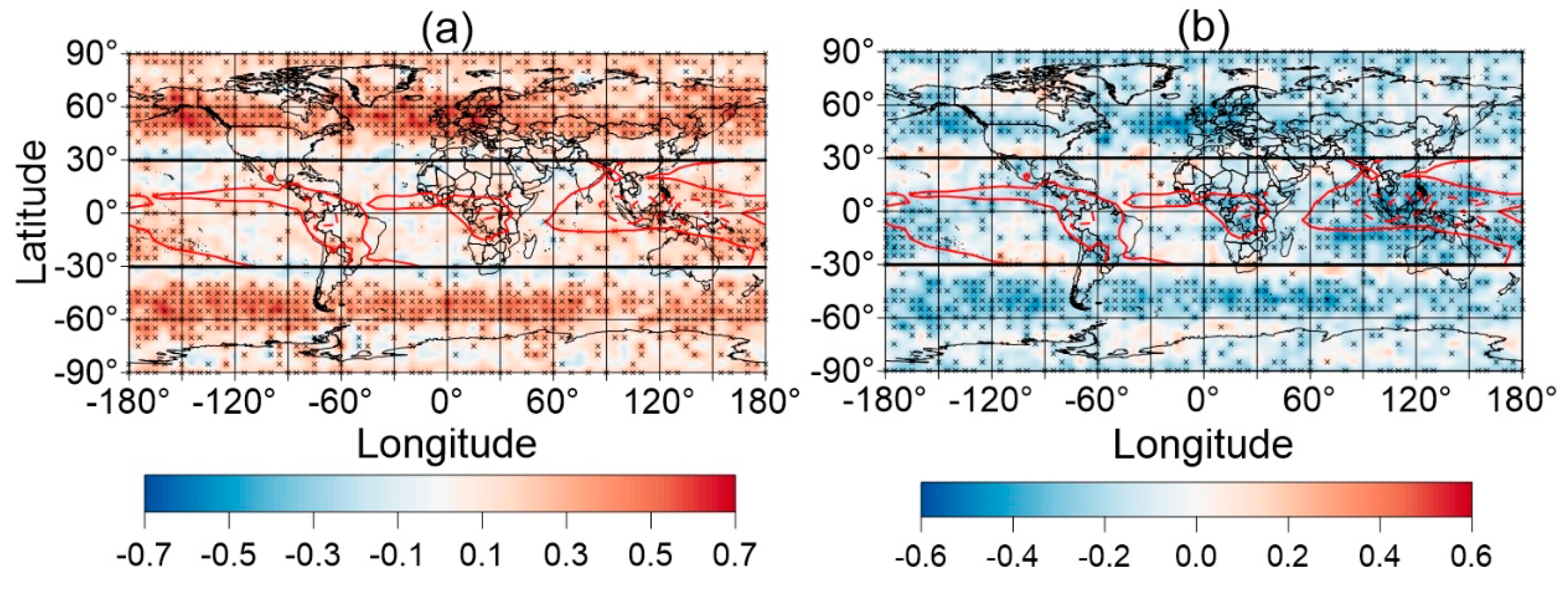
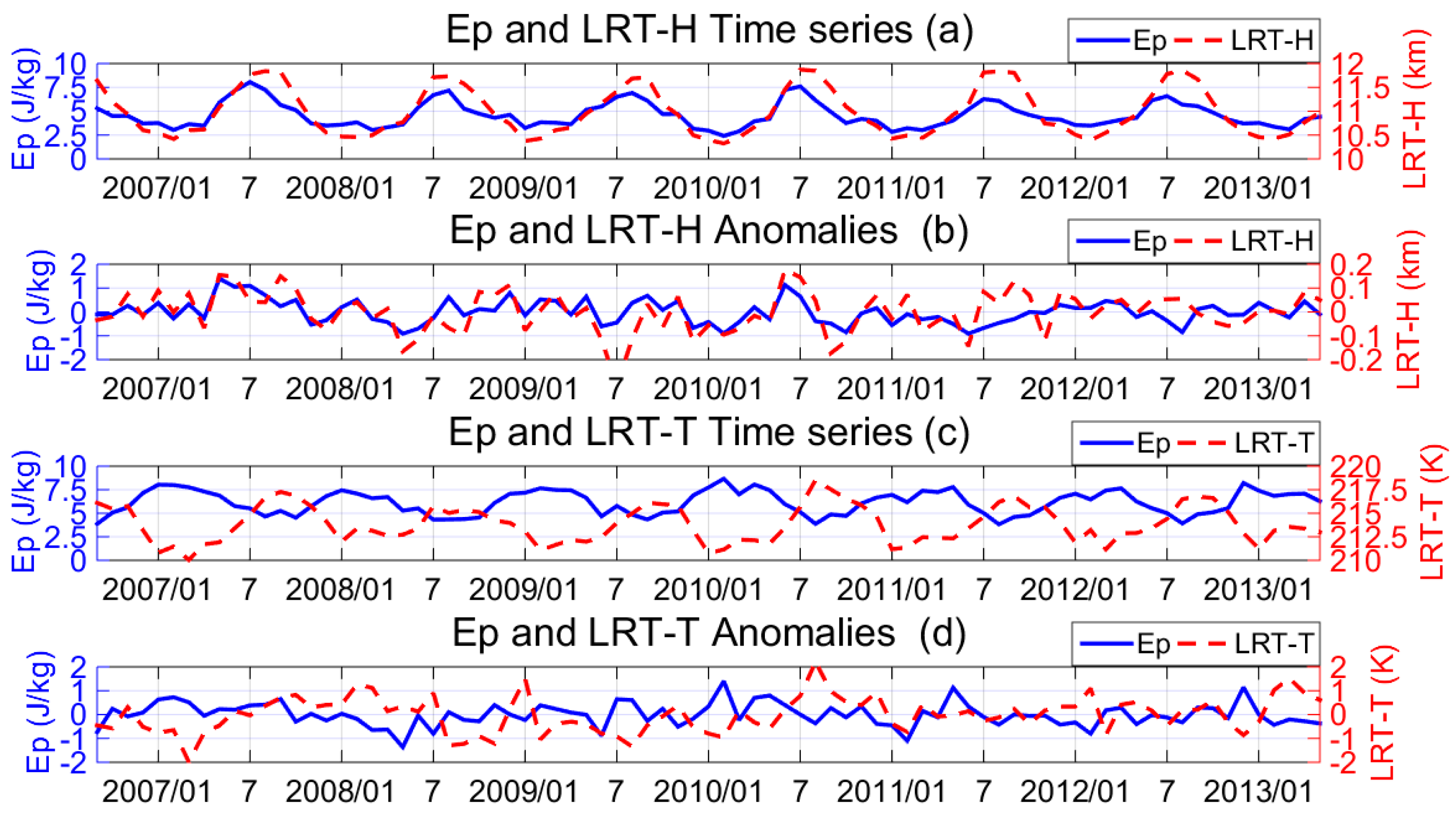
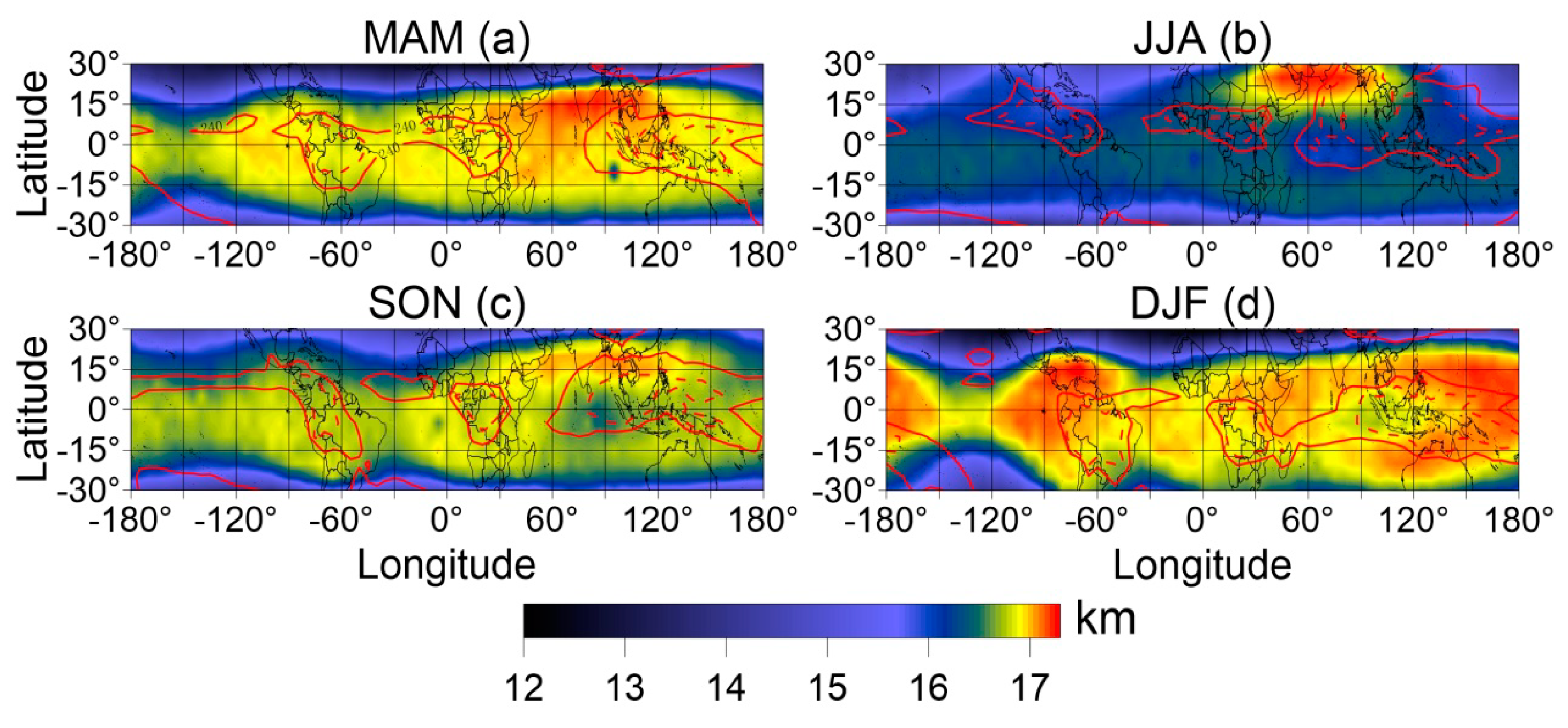
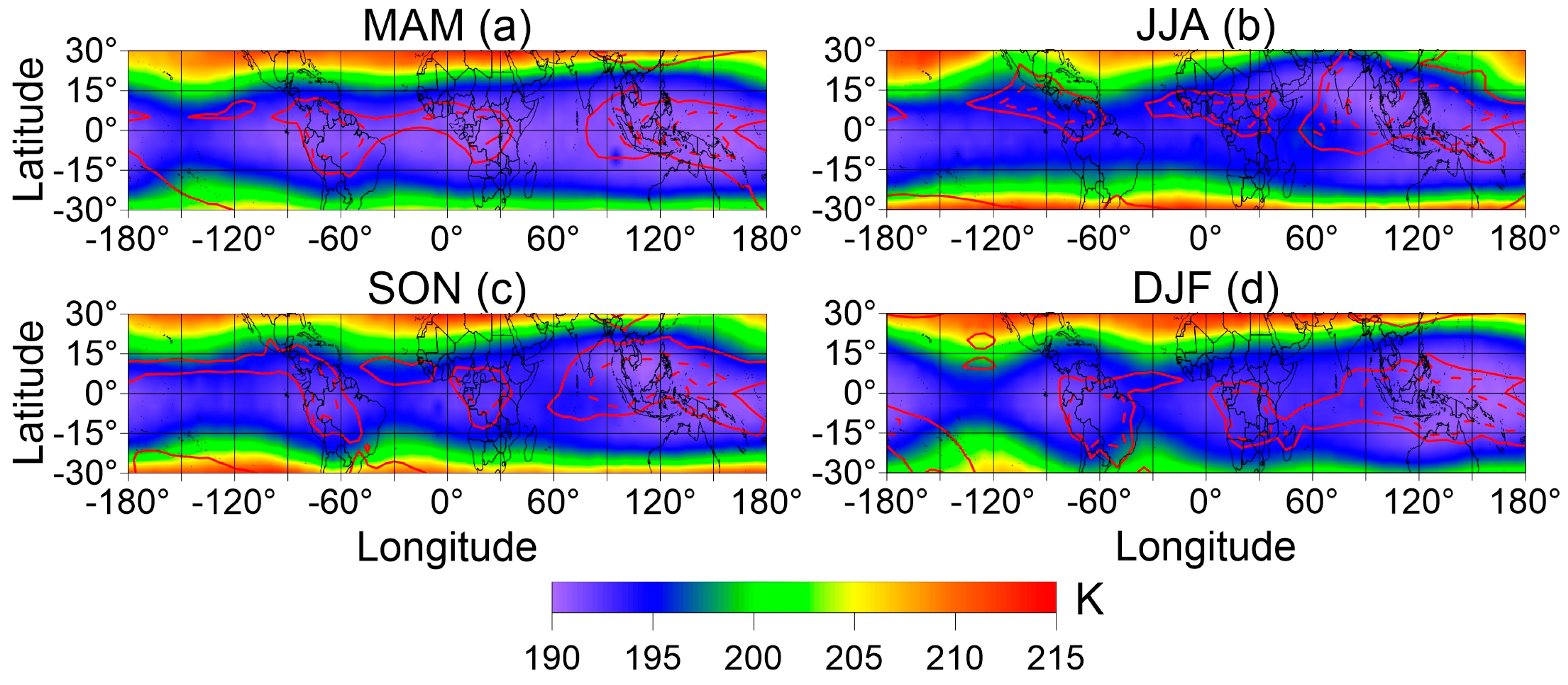
| Season | OLR and LRT-H | OLR and LRT-T | OLR and CPT-H | OLR and CPT-T | ||||
|---|---|---|---|---|---|---|---|---|
| CC | CL | CC | CL | CC | CL | CC | CL | |
| MAM | −0.12 | 67.8% | 0.63 | 99.9% | 0.11 | 60.7% | 0.64 | 99.9% |
| JJA | 0.62 | 99.9% | 0.34 | 99.6% | 0.57 | 99.9% | 0.37 | 99.9% |
| SON | 0.40 | 99.9% | 0.52 | 99.9% | 0.46 | 99.9% | 0.54 | 99.9% |
| DJF | 0.26 | 97.4% | 0.54 | 99.9% | 0.44 | 99.9% | 0.56 | 99.9% |
© 2019 by the authors. Licensee MDPI, Basel, Switzerland. This article is an open access article distributed under the terms and conditions of the Creative Commons Attribution (CC BY) license (http://creativecommons.org/licenses/by/4.0/).
Share and Cite
Yu, D.; Xu, X.; Luo, J.; Li, J. On the Relationship between Gravity Waves and Tropopause Height and Temperature over the Globe Revealed by COSMIC Radio Occultation Measurements. Atmosphere 2019, 10, 75. https://doi.org/10.3390/atmos10020075
Yu D, Xu X, Luo J, Li J. On the Relationship between Gravity Waves and Tropopause Height and Temperature over the Globe Revealed by COSMIC Radio Occultation Measurements. Atmosphere. 2019; 10(2):75. https://doi.org/10.3390/atmos10020075
Chicago/Turabian StyleYu, Daocheng, Xiaohua Xu, Jia Luo, and Juan Li. 2019. "On the Relationship between Gravity Waves and Tropopause Height and Temperature over the Globe Revealed by COSMIC Radio Occultation Measurements" Atmosphere 10, no. 2: 75. https://doi.org/10.3390/atmos10020075
APA StyleYu, D., Xu, X., Luo, J., & Li, J. (2019). On the Relationship between Gravity Waves and Tropopause Height and Temperature over the Globe Revealed by COSMIC Radio Occultation Measurements. Atmosphere, 10(2), 75. https://doi.org/10.3390/atmos10020075





